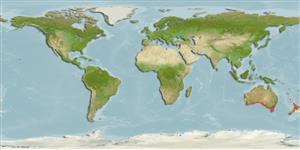分類 / Names
共通名の | 類義語 | Catalog of Fishes(部類, 種) | ITIS | CoL | WoRMS | Cloffa
板鰓亜鋼(サメとエイ類) (sharks and rays) >
Carcharhiniformes (Ground sharks) >
Triakidae (Houndsharks) > Triakinae
Etymology: Mustelus: Latin for weasel, an ancient name for sharks, possibly referring to the pointed snouts, swift movements and/or rapacious feeding behavior of smaller predatory sharks [strictly not tautonymous with Squalus mustelus Linnaeus 1758 since type was designated by the ICZN] (See ETYFish); antarcticus: Latin for southern, referring to its distribution in the southern Pacific around Australia (See ETYFish).
More on author: Günther.
Environment: milieu / climate zone / depth range / distribution range
生態学
海 底生の; 海洋回遊性 (Ref. 51243); 深さの範囲 0 - 403 m (Ref. 76951), usually ? - 80 m (Ref. 6871). Temperate; 28°S - 44°S
Eastern Indian Ocean: endemic to southern Australia, from Western Australia through Bass Strait to Tasmania and northern New South Wales. Possibly extends northward to southern Queensland and Shark Bay in Western Australia. Confused with another undescribed species whose southern distribution extends to Dampier (20°40'S) (possibly Shark Bay) in the west and Bowen (20°S) (possibly Coffs Harbor) in the east. There is a single stock of gummy sharks in the area, however, regional stock differences might still exist.
Length at first maturity / サイズ / 重さ / 年齢
Maturity: Lm 119.5, range 85 - 130 cm
Max length : 157 cm TL オス/雌雄の選別がない; (Ref. 244); 175.0 cm TL (female); 最大公表体重: 30.8 kg (Ref. 40637); 最大記録サイズ: 16 年 (Ref. 6390)
An inshore and offshore shark found from intertidal waters (Ref. 13563) to a depth of 350 m. Feeds on crustaceans, marine worms and small fishes (Ref. 13563), also cephalopods. Forms schools by sex and size . Ovoviviparous (Ref. 50449). Newborn and juvenile gummy sharks are found in many areas across southern Australia, but no well-defined nursery areas have been identified. These sharks are capable of long migrations, females traveling longer distances than males (Ref. 6390). Utilized fresh for human consumption (Ref. 6871). Maximum length data for female species is taken from Ref. 6390.
Life cycle and mating behavior
成熟 | 繁殖 | 放精 | 卵 | 生産力 | 幼生
Ovoviviparous but aplacental, with 1 to 38 pups. Embryos feed solely on yolk (Ref. 50449). Gestation period ranges from 11-12 months. Newborn and juvenile gummy sharks aggregate in many areas across southern Australia but it is not known whether they inhabit defined shallow-water nursery areas. Ovulation takes place in Oct.-Dec. or Nov.- Feb. (WA). Parturition is complete by the following Dec. (Ref. 6390). The sharks are born at 30-35 cm (Ref. 6871).
Compagno, L.J.V., 1984. FAO Species Catalogue. Vol. 4. Sharks of the world. An annotated and illustrated catalogue of shark species known to date. Part 2 - Carcharhiniformes. FAO Fish. Synop. 125(4/2):251-655. Rome: FAO. (Ref. 244)
IUCNのレッドリストの状況は (Ref. 130435: Version 2024-1)
Human uses
水産業: 商業; ゲームフィッシュ: はい
用具
特記事項
XMLをダウンロードして下さい
インターネットの情報源
Estimates based on models
Preferred temperature (Ref.
123201): 14.1 - 19.8, mean 16 °C (based on 126 cells).
Phylogenetic diversity index (Ref.
82804): PD
50 = 0.5000 [Uniqueness, from 0.5 = low to 2.0 = high].
Bayesian length-weight: a=0.00224 (0.00104 - 0.00482), b=3.14 (2.97 - 3.31), in cm total length, based on LWR estimates for this Genus-body shape (Ref.
93245).
栄養段階 (Ref.
69278): 4.5 ±0.59 se; based on food items.
Generation time: 8.9 ( na - na) years. Estimated as median ln(3)/K based on 2
growth studies.
回復力 (Ref.
120179): 低い, 4.5年~14年の倍増期間の最小個体群 (K=0.04-0.30; tm=4-6.9; tmax=16; Fec=1-38).
Fishing Vulnerability (Ref.
59153): High to very high vulnerability (74 of 100).
Nutrients (Ref.
124155): Calcium = 7.05 [2.38, 34.51] mg/100g; Iron = 0.171 [0.058, 0.673] mg/100g; Protein = 21.5 [19.0, 23.8] %; Omega3 = 0.252 [0.110, 0.600] g/100g; Selenium = 21.8 [6.6, 69.4] μg/100g; VitaminA = 10.7 [3.5, 34.3] μg/100g; Zinc = 0.316 [0.145, 0.644] mg/100g (wet weight); based on
nutrient studies.
